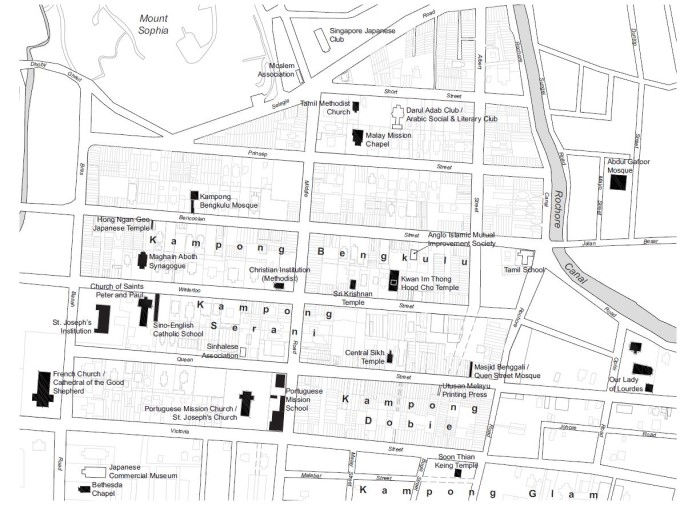Singapore Kampong Serani
- Marc Michelmann
- Sep 29
- 3 min read
Within Kampong Bengkulu was Kampong Serani in the vicinity of Queen Street and Manila Street. ‘Serani’ is the Malay equivalent of the Arabic ‘Nasrani’ (Nazarene), which refers to Christians. Among Malay speakers of the past, Portuguese Eurasians, who were typically Catholic, were known as Serani.
Kampong Serani, which was bounded by Hokkien, Manila and Queen streets, was called Sek-kia-ni Koi (Serani Street; a transliteration of ‘Serani’) in Hokkien. Kampong Serani was known for its Eurasian community, the offspring of intermarriages between local women and early European settlers.

Burgeoning Catholic and Christian Populations
A Eurasian neighbourhood was clustered around the Portuguese Mission, which later built St Joseph’s Church in 1953. Prior to this, members of the Portuguese Mission community used to gather at the house of Jose d’Almeida, a Portuguese surgeon who came to Singapore to start a dispensary and subsequently became a successful merchant. D’Almeida’s residence was a mansion along the seafront Beach Road before the coastline was pushed out by reclamation.
Church of Saints Peter and Paul, No. 224 Queen Street
Although predominantly Catholic and Christian, the resident makeup of Kampong Serani was far from homogeneous. Besides the community of Catholic Eurasians, there were many other groups affiliated to various Catholic missions and Christian denominations, whose churches and communities were embedded in the area. These communities were in fact multiethnic and multilingual.
Initially, most Catholics worshipped at Singapore’s only Catholic chapel on Bras Basah Road, built in 1833 at the site that was later occupied by St Joseph’s Institution, and today the Singapore Art Museum. As the congregation grew, however, another larger place of worship was completed in 1847 — the Church of the Good Shepherd located at the corner of Bras Basah Road and Queen Street. Subsequently, more churches in the surrounding area sprang up catering to specific ethnic groups and Christian denominations as the various communities expanded.
The first Catholic community to establish its own church was the Portuguese Mission, who built the original St Joseph’s Church in 1853 on Victoria Street (the building we see today is a newer construction dating to 1912). Chinese- and Tamil-speaking Catholics were served by the Church of Saints Peter and Paul on Queen Street that was built in 1870. As the Tamil congregation expanded, however, they moved to the Church of Our Lady of Lourdes on nearby Ophir Road, founded by the French mission from Pondicherry in 1888. A short distance away at Short Street, the Tamil Methodist Church was built here in 1887, signalling the burgeoning Methodist community in the area.
Meanwhile, the Baba Malay-speaking Chinese Peranakan community from Melaka formed the Straits Chinese Church, also referred to as the Malay Chapel, in 1843. This later became Prinsep Street Presbyterian Church, which was also known as the Prinsep Street Baba Church. Besides locally born Straits Chinese, the Chinese Peranakan community from Bencoolen and some Teochew speaking Christians also joined this congregation. Another Baba Malay-speaking church, Straits Chinese Methodist Church, at the intersection of Middle Road and Waterloo Street was inaugurated in 1894.
Compound Shophouses
Many Eurasians lived in compound shophouses — a dwelling formed by setting back a row of shophouses or terrace townhouses and enclosing the front yard with a low brick wall, thus creating a small front compound. The houses were also raised from the ground with a short flight of steps leading from the front yard to the terrace. At one point, there were 15 rows of such compound shophouses in the vicinity of Kampong Serani.
Zena Tessensohn née Clarke recalled living in a bungalow on a lane opposite the Church of Saints Peter and Paul:
“Many Eurasian families lived in Queen Street… We used to visit each other’s compounds or gardens and play hide-and-seek and catching. The boys used to fly kites and play marbles… [The] younger members mixed and played together a great deal, especially as the open compound of the older row of houses allowed for participation by large numbers in games such as hantu galah, rounders, etc.”
However, this architectural typology did not extend to the newer style of shophouses, as Marie Cockburn née de Souza remembered:
“The newer second row of shophouses had no common compound. Rather, each house had an enclosed concrete area leading from a gate to the front verandah of the house. This area could be used for parking a car or for lining potted plants.”
As the Eurasian community flourished in Kampong Serani, so did institutions and businesses owned by Eurasians that supported their social and economic lives. There was a Eurasian-run pineapple factory on Bencoolen Street as well as an Italian bakery and the Mercantile Institution on Queen Street, the latter founded by P.E. Pereira, who also served as its principal. One of the compound houses on the same street was converted into the Mercantile Hostel.
Source: https://www.roots.gov.sg/stories-landing/stories/forgotten-histories, September 2025




Comments